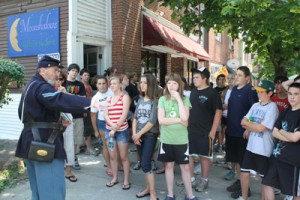
During a walking tour of the St. Albans Raid on June 11, Jim Fouts tells St. Albans Town eighth graders what happened during the infamous Confederate raid on St. Albans in 1864. The group stands where a man was shot and killed during the raid.
Nearly 250 years after the northern-most battle of the Civil War unfolded on the streets of St. Albans, some of the town’s students this week caught a glimpse of the infamous St. Albans Raid.
Guided by Civil War re-enactor Jim Fouts, students from Patrick Hartnett and Abby Lanfear’s St. Albans Town Educational Center eighth-grade class on Monday, June 11, 2012, walked through downtown St. Albans to see what landmarks played roles in the raid.
St. Albans’ little slice of Civil War history came courtesy of Bennett Young, a Confederate lieutenant who devised a plan to infiltrate the North through Canada. After planning the raid in Canada, Young and about 20 other Confederates slowly made their way to St. Albans before taking to the streets on Oct. 19, 1864, robbing three banks throughout town before their failed attempts to burn several landmarks.
While Fouts said the raid took place on a rainy, dreary day, Monday was anything but rainy and dreary. Stopping from one landmark to the next, Fouts took time to explain what buildings played roles in the raid and how they’ve changed since the Civil War.
With the tour beginning at Taylor Park in front of the St. Albans Historical Museum, Fouts explained how the former school building’s students witnessed the raid through the third floor windows.
Fouts then led the students to Congress Street, the site of Gov. Gregory Smith’s house that Bennett Young had planned to burn, but ultimately failed to do during his and his soldiers’ escape.
Fouts said like many of St. Albans influential people, Gov. Smith was absent for the raid, diminishing the attack’s impact.
“Many of the important men were not in town that day,” Fouts said, pointing out that the sheriff, too, was out of town.
Down on Main Street, Fouts told the students how the cite of City Hall used to be a hotel, the Tremont House, and many of the confederates stayed there in the days leading up to the raid.
After stealing horses from various downtown stables, the raiders went to the three banks, stealing as much money as they could, Fouts said. Trying to make a quick getaway, however, the Confederates accidently left several thousand dollars in uncut bills, thinking the roll was wallpaper, Fouts told the amused students.
With such few men, Fouts said, the raiders had to be efficient with what they brought to St. Albans. Not wanting to attract the attention of the masses of railroad and foundry workers just a block away on Federal Street, the raiders posted guards at that road and Champlain Street, which is now Lake Street to inhibit anyone from alerting the hundreds of workers in that area, Fouts said. Noise from the railroad most likely cover upped their gunfire and shouted commands.
Considered a Confederate victory, the raid ended with most of the rebels escaping to Canada and escaping punishment or extradition after several trials, Fouts said.
While the St. Albans Raid may have lacked the carnage and drama of other Civil War battles — there was only one casualty and the Confederates were only able to burn a storage shed before escaping to Canada with more than $200,000 — Fouts’ history lesson opened the eyes of several of the SATEC students.
Eighth-grader Sean Hengemuhle said he didn’t fully realize all the action that took place on the streets of his hometown.
“It was surprising,” he said. “There was a lot of action in St. Albans.”
Hannah Gamsby said she always knew of the Civil War connection in St. Albans, but walking through the town to see where the action took place was an interesting experience.
“I knew there was something that happened here,” she said. “I think it was really neat to learn about our town.”
Opening their students’ eyes to the town’s unique place in Civil War history was part of Hartnett and Lanfear’s curriculum this year. After reading several Civil War-themed books throughout the year, Lanfear said the tour was a way to cap off their unit.
“This is the culminating activity to our Civil War novel unit,” said Lanfear, the class’s literature teacher. “We have such a unique connection to the Civil War and now they understand so much more. They’re really able to make that connection.”
Hoping to make the St. Albans Raid tour an annual event, Hartnett said his students have an unlimited amount of resources to learn about their town’s history.
“We’re on the Civil War map, and we should recognize that,” he said. “To have our own little niche is pretty neat.”
One of the resources Hartnett hopes to take advantage of in the future is the St. Albans History Museum. Allyn McDonald, the museum’s director, said he’s trying to incorporate the St. Albans schools to drive the interest in the town’s history.
“I’d love to get the schools in here more,” said McDonald.
By IAN LORD
St. Albans Messenger Staff



